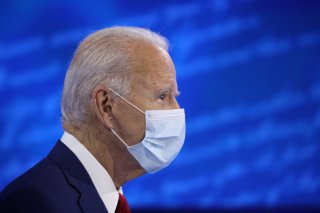Is Joe Biden’s Talk About A Close Race Really A Head-Fake?
Could this be the winning strategy to ensure 2016 doesn't repeat itself?
Democratic nominee Joe Biden’s campaign advertisements and staffer remarks that the race for the presidency is far tighter than what polls have reported have spurred election nerves among some party members. But considering a double-digit national lead and record-high fundraising in September, Biden may be using the tactic from the modern campaign strategy playbook to energize voters to push President Donald Trump out of the White House.
In past presidential campaigns, candidates have slung lies, deceit, and manipulation through negative campaigning and dirty tricks to mislead voters. There are several different moves that a candidate can take in terms of ushering an elusive campaign including confusing voters or knocking down a public image or reputation.
An old campaign trick --- confusing the voter -- has been used for decades, and some analysts even accused Trump of effectively practicing it with Kanye West, as the musical artist has appeared on the presidential ballot in several states for the 2020 election. The tactic aims to siphon votes from a major party or competitor to the unrealistic or distracting candidate, so that the other major party candidate has a stronger chance at winning the election. Arizona saw this method in effect in 2010 when a Republican candidate recruited homeless people to run as members of the Green Party, with one of the homeless candidates being a tarot card reader who intended to run for State Treasurer. Democrats and members of the Green Party were outraged at the move and filed a lawsuit.
Biden’s potential strategy to persuade Americans to vote by conveying a tight race isn’t necessarily bogus.
Democrats and Biden supporters swarmed social media after the former vice-president’s campaign manager Jen O’Malley Dillon said that the race for the White House is “a lot closer” than conventional wisdom suggests.
“Early voting is already underway in many states,” Dillon said on Twitter. “Millions of voters have already cast their ballots. But there is still a long way to go in this campaign, and we think this race is far closer than folks on this website think. Like a lot closer.”
“The next few weeks are going to be hard,” O’Malley Dillon added in the same thread. “I tell our team every week that ‘we can do hard things.’”
In recent weeks, Biden’s campaign has flooded social media with copy noting, “We can’t let history repeat itself,” resurfacing a tight 2016 race between Trump and then-Democratic nominee Hillary Clinton.
The campaign also refers to state polls that Biden and Trump appear neck-and-neck, begging Americans to donate to his campaign or go exercise the right to vote.
Perhaps Dillon’s remarks on Twitter raised the most concern among Democrats, as they boosted overall uncertainty in trusting the results of the polls and the widespread media coverage of Biden holding leads nationally and in battleground states.
While the warnings from Biden’s campaign might be strategic, it could also just be legitimate.
According to Thomas Edsall’s piece in The New York Times, a Biden victory isn’t guaranteed as voter behavior from the 2016 election “still hovers in the rearview mirror.”
Edsall said “In recent months, there have been substantially more Republicans added to the rolls than Democrats” in swing states like Florida, North Carolina and Pennsylvania -- all states the president narrowly won in 2016. He outlined that across the three states, nearly 415,000 Republicans have registered within the last few months, while only 193,000 Democrats registered, posing a major threat to Biden’s election bid.
Although there are some concerns about the former vice-president chances at landing a spot in the Oval Office in November, Biden has pushed into crucial voting groups that Trump dominated from four years ago including whites without college degrees, white men, middle-income whites and married men, as reported by Edsall. He’s also maintained a massive advantage among white women with college degrees, young voters between the ages of 18 and 29, high-income voters and single women.
Biden also has rallied a stronger polling lead than Clinton garnered in 2016. FiveThirtyEight reported Friday that Biden has a 87 percent chance at winning the election that’s less than three weeks away.
These reports of a strong Biden candidacy provide a backbone of how the recent alerts launched from his campaign might be a strategy that confuses voters into believing the race is a lot tighter than anticipated, compelling them to register and then vote. At a minimum, it prevents his supporters from growing complacent.
Rachel Bucchino is a reporter at the National Interest. Her work has appeared in The Washington Post, U.S. News & World Report and The Hill.
Image: U.S. Democratic presidential candidate Joe Biden approaches his seat, ahead of an ABC Town Hall event at the National Constitution Center in Philadelphia, Pennsylvania, U.S., October 15, 2020. REUTERS/Tom Brenner.

